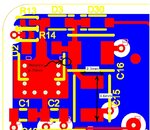T
treez
Guest

Hello
Our PCB layout contractor has placed two 1210 capacitor footprints on our PCB. The dimension of the copper on these is 4.6mm x 2.3mm (L X W) as in the attached.
A 1210 footprint can be in worst case 2.7mm wide.
He tells us that this doesn’t matter.
Is he right? Or will our ceramic capacitors not solder properly?
Our PCB layout contractor has placed two 1210 capacitor footprints on our PCB. The dimension of the copper on these is 4.6mm x 2.3mm (L X W) as in the attached.
A 1210 footprint can be in worst case 2.7mm wide.
He tells us that this doesn’t matter.
Is he right? Or will our ceramic capacitors not solder properly?





